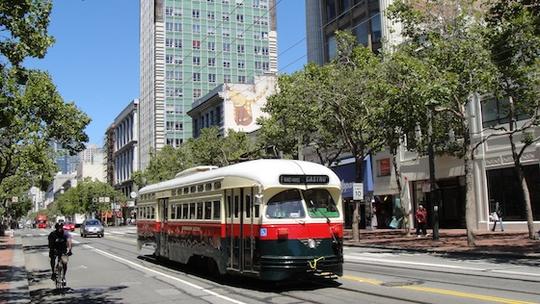John King, the Chronicle’s urban design writer, has a good piece today about some aspects of the proposed Market Street redesign. They’re about six weeks behind us though, when it comes to discussing the number of streetcar stops that should be retained as part of the revamp of our main street.

A key goal of the Better Market Street project is to make the street better for transit and bikes.Autos? Eh, not so much.
John called us to get our take on the possible reduction of F-line stops from 12 to either 9 or 6. We told him we had an open mind on the subject, provided of course any changes helped speed the flow of transit along the street. As one example, we suggested that replacing the current stops at Fourth and Fifth with a larger, fully accessible stop at Powell might actually be an improvement, while freeing vital street space for other uses (like a bike track) in the constrained area next to the BART escalator shafts where the streetcar stops are now.
Bottom line: it’s all about thinking carefully about what works, rather than reflexively assuming every stop has to remain. We all want the F-line to load and unload more quickly, to reach the boarding islands quicker and more reliably and to avoid getting stuck behind other traffic unnecessarily.
Your opinion counts here. Either leave a comment below or (preferably) give feedback direct to the Better Market Street Project. Click the comment button at the top of that web page.
Oh the Chron… It did mention what I’d not remembered hearing here, that the “F” was to be isolated in two center lanes, and no longer run in traffic. Did I read that right? As I argue below, car traffic isn’t the problem and isolating the “F” ruins the authenticity of Market street historic transit. True, the traffic was to be buses, not cars, but did I also read that ALL the buses are going to the curb? Is that a good idea?
As a bus and former “F” operator, it wasn’t cars that slowed us down, at least not on Market, most of the time. Cars are an issue crossing Market, specifically at First, Montgomery/New Montgomery, third and fourth. And now with the Stockton buses turning on 5th, both are causing some headaches, inbound, there. We should have the painted intersection “boxes” NYC had, where getting stuck in them brings points to your driver’s license: In other words, stop if you don’t see any room on the far side, enter the striped intersection zone on a stale light at your peril.
The biggest issue I have is getting through the lights, outbound, from the foot of Market across Main—especially on the “F”. They never run in favor of my bus or streetcar. Otherwise, it’s other operators—on the lines that use the “F” islands—those on the “F” specifically who sit and talk through multiple lights rather than load and leave, and answer questions on the fly. The curb lane buses have issues with turning cars and other vehicles, but I’ve not driven those enough to comment.
How many stops were there in 1906 (in Trip Down Market Street, for example)? Given how things seem to be generally messed up now, it might be good to go to back to the olden days when it seemed things were done right — or at least better in some cases. It doesn’t mean we need to copy it exactly; but it might be good for reference. Balance is key, as you allude.
By the way, you all do very fine work here. I rarely visit this website unfortunately, but it’s really impressive and stands out from the rest of the Internet. I’ll contact you when I have time in the future to help.
Keep those beautiful cars running!
Pre-earthquake, cable cars on Market would generally stop at the corner of any intersection on the south side of the street, much like today. But as you can see from that wonderful video (available in our museum and online store, plug, plug, at https://www.streetcar.org/store), the traffic scene was worlds different then.